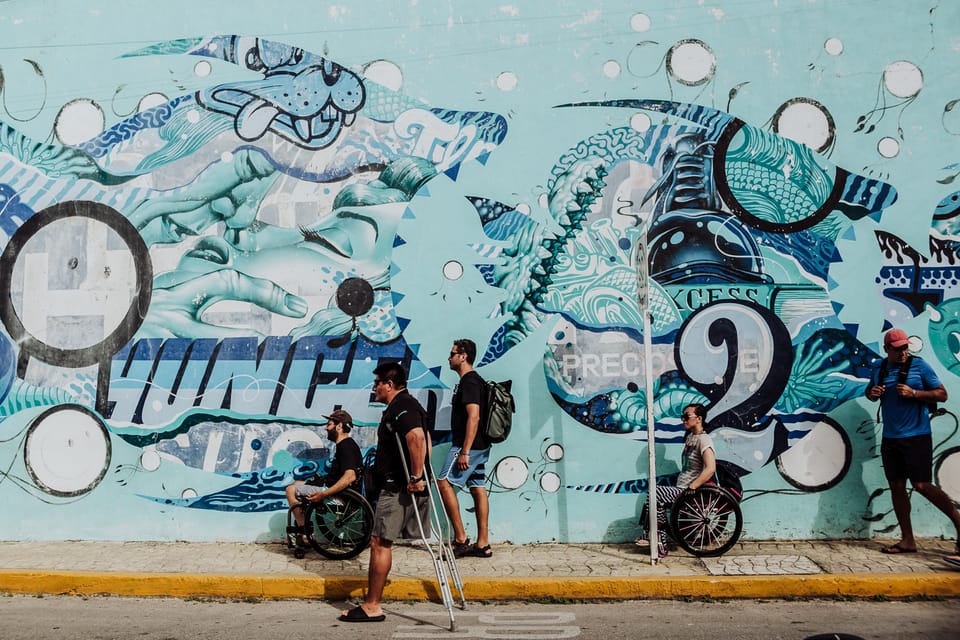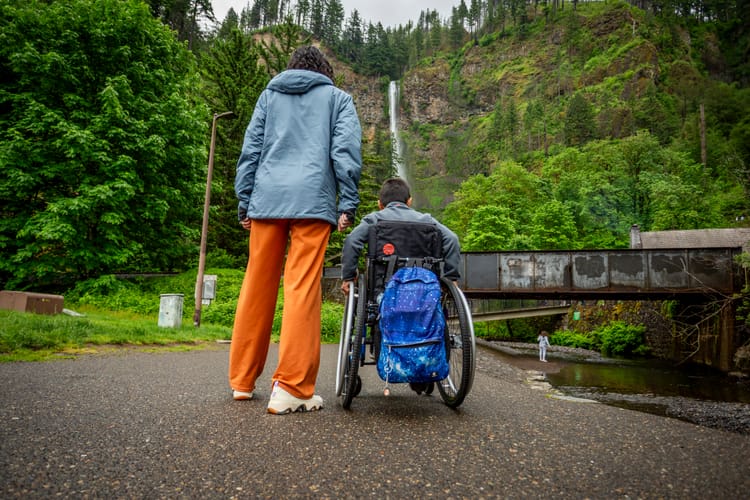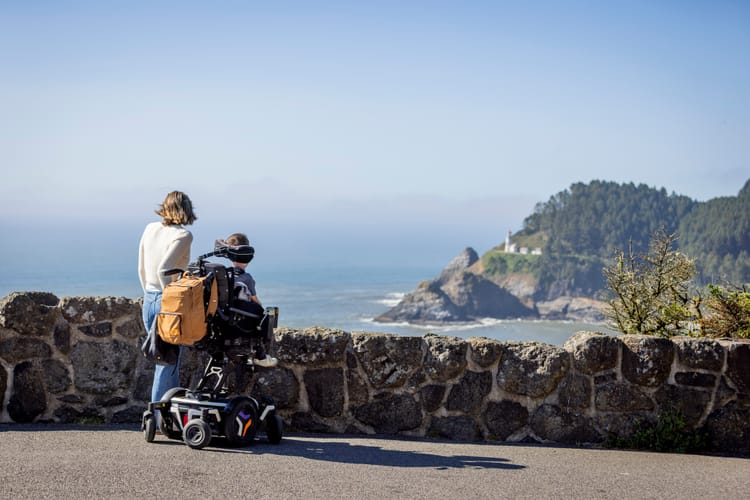Tips for Traveling with Mobility Aids

Embarking on a journey holds a special kind of magic, the promise of new places, cultures, and experiences. We understand—travel is exciting, and everyone should have the chance to dive into it headfirst.
Now, we know that when you're exploring the world with a mobility aid, the adventure takes on its own unique factors. There are extra elements to consider. In this article, we will discuss the important phases of travel and provide tips, insight, and considerations as it pertains to mobility aids.
Tips for Planning Accessible Travel with Mobility Aids
Let's review some helpful recommendations when planning your trip to ensure it can go as smoothly as possible. Of course, nothing ever goes perfect during travel, but these tips can help prevent some of the potential issues and mitigate stress.
Researching Accessible Destinations
Not all destinations are created equal when it comes to accessibility. Before you set your heart on a location, do some research on the destinations you'd like to travel to. Here are a few things to consider:
- Accessible accommodation: are there hotels in the area that offer the accessibility features that suit you? Also consider the location within the city. Staying in close proximity to the top sites, attractions, and things you want to do will add extra convenience. If you are close to everything, you won't have to worry about transportation as much since you are within walking distance.
- Attractions and tours: does the destination offer reliable tours for those with limited mobility? Typically, larger cities will have far more options than a remote, rural town. Make sure to research all of the things you want to do and see. Check out their websites, reviews, and even contact them to ask any questions you need to know about accessibility.
- Transportation: do you plan on renting an adaptable vehicle, using public transportation, or ride-shares such as Uber or taxis? For example, places like Europe offer excellent public transportation and many of the major cities there have adapted for accessibility, making it a reliable option. In the U.S, you will find train transportation in major cities, but other areas don't offer the best public transport. Planning your routes and itinerary in advance will help you navigate the best ways possible with the mobility aid you use.
Plan Far in Advance
When it comes to accessible travel, foresight is your best friend. Plan your trip well in advance to ensure you have ample time to address any specific needs. This includes booking accessible accommodation, transportation, and activities. Contact the hotel and tour operators to double check the accessibility information is reliable. It's also a good idea to have a backup plan in case of any unforeseen challenges.
Plan your routes and itinerary. This way you will be able to know exactly what to expect and the best route to the next attraction. Consider even hopping on google maps to see what the street views look like. This can be helpful for planning your daily itinerary.
Planning ahead also pertains to airports and flying. Research the airline's policies for traveling with mobility aids. Although many of them have similar protocols, there may be some differences among them. When you book a ticket, there is typically an option with your booking to check that you're flying with a mobility aid. To be extra safe, contact the airline right away and let them know the details. The airline representative will then make a note on your reservation.
Choosing An Accessible Accommodation
Your home away from home should be a sanctuary of comfort and accessibility. Look for hotels, resorts, or vacation rentals that prioritize accessibility. Check for features like ramps, wide doorways, accessible bathrooms, and other accommodations that suit your specific needs.
One of the major problems we see in the accessible travel industry is either a lack of information, inaccurate information, or both. It’s common to see an “accessible” sign slapped on a hotel’s website without details. For travelers with mobility aids, accurate information is not just important, it’s absolutely paramount.
To combat this common problem, booking through a dedicated accessible travel company will make the process and research far easier. Wheel the World is devoted to providing accurate, reliable, and verified information to ensure you can find accessible accommodations (and more) that suit your needs.This is done through a comprehensive mapping program. By compiling over 200 measurements and data points focused on accessibility, travelers can book worry-free trips. For further details on how the information is gathered, check out this article.
Tailoring Activities
Every traveler has their own bucket list, and yours should be no different. Tailor your activities to your interests while keeping accessibility in mind. Whether it's exploring historical sites, enjoying outdoor adventures, or exploring the local beaches, there are options out there. Many destinations have local tour operators that can help you. They'll often provide a service for accessible tours and the right equipment for activities. Research to see what the local area has.
Depending on the destination, some websites detail their accessibility information, so make sure to research each attraction/activity to see if it's doable for you (some destinations are far better than others with this).
Don't hesitate to call them as well. Wheel the World also provides accessible tours, activities, and packages that cater to accessibility needs.
Tips for Flying with Mobility Aids and Navigating the Airport
Air travel is an adventure in itself. For some, it is the most stressful aspect of travel. However, with a few considerations, tips, and insights, it can turn into a smoother experience.
What Mobility Aids Can Be Taken on a Plane?
- Manual Wheelchairs: airlines are required to have room in the cabin for at least one folding wheelchair. Make a request to pre-board the flight so there's room for you to do so. If there is more than one person flying with a manual wheelchair, the space is available on a first-come-first-serve basis. If you aren't able to have it on-board, then the wheelchair will be checked upon boarding and a wheelchair attendant will assist with transferring via an aisle chair. You can request that the wheelchair be brought to you upon arrival close to the aircraft door.
- Walkers: very similar to wheelchairs, walkers will typically be checked at the gate. You can request the walker be brought to you upon arrival.
- Canes: because canes are a mobility aid and aren't considered luggage, they are permitted to come with you on the plane. A flight attendant can help you stow it somewhere. Folding canes that fit properly under the airline seat can usually be taken with you to your seat or packed in your carry-on if you don't need it during the flight.
- Power Wheelchairs: Power wheelchairs cannot be taken on-board as there hasn't been any protocols to allow for this. For flying with a power wheelchair, check out this article that covers this topic in depth.
Notify the Airline in Advance
Communication is key. Notify the airline of your specific needs well in advance. This allows them to make necessary arrangements, make a note on your reservation and ensure a smoother process for you.
- Tell them your situation and any personal needs, such as the need for assistance through the airport or to the airplane seat.
- For wheelchair-users, give the airline the details of your chair like the dimensions, weight, and type of battery for power-wheelchairs.
Choose an Aisle Seat
Selecting the right seat can make a significant difference. Upon booking, try to select an aisle seat and, if possible, as close to the front as possible. This simple tip allows for transfers to go smoother.
Arrive Early
Give yourself ample time. Arriving early allows you to go through security and boarding processes at a comfortable pace. When you request airport assistance, sometimes the attendant won't be available right away.
Going Through TSA
If you are not able to walk through the TSA metal detector, passengers can request to have a manual pat-down by a TSA agent. You can request the pat-down to be conducted by an agent of the same gender.
If you use a cane, the cane will have to go through on the belt for screening. If you are unable to walk through the security detector, the TSA agents will either do a manual pat-down or bring your cane back to you afterwards and you can go through the screening machine.
Remove Parts to Prevent Damage
If you are flying with a wheelchair, remove or fold any vulnerable parts to prevent damage. Consider parts such as the headrest, footrest, joystick, and armrests. Also, remove your cushion and put it on your plane seat. Bring an extra carry on and bring the removed parts on the plane with you. Ask a flight attendant to help you store those parts safely.
Notify the Airline of Any Damage
If you notice damage has been caused during transit, go immediately to the airline customer service counter and file a claim. For domestic flights, U.S carriers must compensate you in the event that your mobility aid is lost or damaged.
Know Your Rights
Knowledge is power. Familiarize yourself with the Air Carrier Access Act (ACAA), a U.S. law that prohibits discrimination on the basis of disability in air travel. This act ensures that air travel is equally accessible to all individuals, regardless of their mobility challenges.
Final Thoughts
Accessible travel is not just a possibility; it's a celebration of the spirit of adventure. With the right information and preparation, individuals with mobility aids can embark on journeys that are enriching, fulfilling, and, above all, accessible.
So, embrace the excitement of travel. Let the wheels of your mobility aid be the companions on a journey filled with discoveries.
As you set forth on your next trip, remember: travel knows no limits, and neither do you. May your adventures be boundless, your experiences unforgettable, and your spirit forever free. Safe travels!
Find Your Dream Accessible Trip
With detailed and accurate information on accessibility





Comments ()